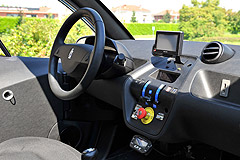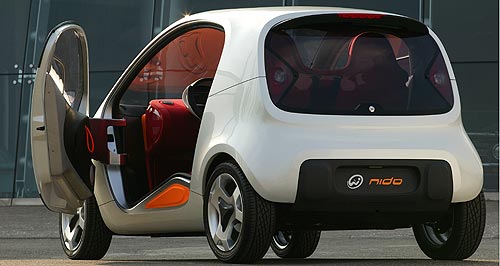Make / Model Search
Future models - Pininfarina - NidoPininfarina electrifies Nido microItalian EV: Pininfarina celebrates 80 years with the all-electric Nido concept. Famed Italian design firm Pininfarina extends EV program with reborn Nido11 Jun 2010 By TERRY MARTIN ITALIAN design house and contract car manufacturer Pininfarina has broadened its electric vehicle program beyond the Bluecar joint-venture with the French Bollore Group, dusting off the Nido nameplate to herald a new family of hybrid and electric cars. Recently unveiling the Nido EV as part of its 80th birthday celebrations, Pininfarina has taken its original Nido two-seater concept car – first unveiled at the 2004 Paris motor show – and developed it into an electric prototype that it hopes to build in limited numbers for car-makers and large fleet organisations, such as electricity utilities. The Turin-based firm does not intend to compete head-on with global car-makers, but said it could assist them introduce an EV into their line-up in a short period of time. Production volume is understood to be targeted at below 10,000 units a year. According to Pininfarina, the modular nature of the vehicle platform means the Nido can be adapted for full-electric and hybrid powertrains as required and across four different body configurations: two-seater, four-seater, pick-up and light van. While the body structure of this first prototype is a tubular steel frame, Pininfarina said the final version would have an aluminium space frame. Chief executive Silvio Angori said the company was aiming to become “the benchmark in Italy, and further afield, for sustainable mobility, just as it has been the global benchmark for style for the last 80 years”. “We will continue to ‘dress’ technology and we will offer even more industrial design services, continuing to play a key role as a design house and an innovative partner with unique skills,” Mr Angori said. “Consistent with our industrial plan, we will maintain our commitment to sustainable mobility – in other words both the development and production of electrical vehicles (cars and buses), and research into both alternative components and materials, and aerodynamic shapes that can help to make vehicles lighter and reduce their consumption and emissions. “And finally, we will concentrate on the creation of value for our brand, whose potential derives from the reputation it has built up in 80 successful years.”  The Nido EV is part of what Pininfarina calls the Nido Development Program, which has at its core an electric city car family “conceived, designed and built entirely” in-house. The Nido EV is part of what Pininfarina calls the Nido Development Program, which has at its core an electric city car family “conceived, designed and built entirely” in-house.Pininfarina_Nido_stack.jpgThe electric Nido is described as marginally larger than a Smart and has a rear-mounted electric motor that draws energy from a 278-volt 21.2 kWh Zebra Z5 nickel sodium chloride battery. Maximum power output is 30kW, with maximum torque to the rear wheels of 125Nm. When fully charged, the Nido EV is said to have a range of 140km, 0-60km/h acceleration of 6.7 seconds and an electronically limited top speed of 120km/h. Recharging time is rated at eight hours. Preliminary specifications show the vehicle weighs around 900kg (with the battery taking up 182kg), and measures 2905mm long, 1683mm wide and 1507mm high. It is also said to be 100 per cent recyclable at the end of its life, including the battery which can be used to produce stainless steel. Under the development program, Pininfarina is also working on hybrid versions, including a range-extending plug-in electric model which, like General Motors’ Volt, includes a small conventional engine that acts as a generator rather than the main power source. The program also covers research into fuel-saving vehicle climate-control technology, various energy-saving solutions (such as batteries with first-rate charging performance), the use of lightweight components with a high mechanical/electrical efficiency, and braking systems specifically for hybrid or full-electric applications. The exterior design updates the “lines and volumes” of the 2004 Nido, which won a string of awards around the time of its release, including a gong for the ‘Most Beautiful Car in the World’. The interior is still a work in progress. As GoAuto has reported, Pininfarina is also working with the Bollore Group to bring the full-electric four-seater Bluecar to market as early as next year. This is a bigger-volume project and uses different technology, including a lithium metal polymer battery that enables the Bluecar to reach a maximum speed of 130km/h and offer a range of 250km. Overseas reports indicate that the Pininfarina remains on track to put the Bluecar into production late in 2011, and that the order bank has climbed to 10,000. The Italian firm’s other recent eco model was the stunning Sintesi four-door, four-seat, fuel-cell sportscar, unveiled at the 2008 Geneva motor show. The Sintesi featured individual fuel cells located at all four wheels, delivering 20kW of power each and giving the vehicle a total of 80kW, with a rechargeable on-board battery providing a further 20kW to each wheel in ‘sport’ mode. Pininfarina claimed that acceleration from 0-100km/h was 7.5 seconds with the full 160kW on tap. With a low aerodynamic drag factor of 0.27Cd, the Sintesi had a top speed of around 250km/h, although the battery power would last less than five minutes under maximum load.  Read moreAll future models Alfa Romeo Alfa Romeo Abarth Abarth Alpine Alpine Alpina Alpina Audi Audi Aston Martin Aston Martin BMW BMW Bentley Bentley Chery Chery Brabham Brabham Chrysler Chrysler Chevrolet Chevrolet Cupra Cupra Citroen Citroen DS DS Dodge Dodge Fiat Fiat Ferrari Ferrari Foton Foton Ford Ford Great Wall Great Wall FPV FPV Haval Haval GWM GWM Honda Honda Holden Holden Hummer Hummer HSV HSV Infiniti Infiniti Hyundai Hyundai Jaguar Jaguar Isuzu Isuzu Kia Kia Jeep Jeep Land Rover Land Rover Lamborghini Lamborghini Lexus Lexus LDV LDV Mahindra Mahindra Lotus Lotus Mazda Mazda Maserati Maserati Mercedes-AMG Mercedes-AMG McLaren McLaren MG MG Mercedes-Benz Mercedes-Benz Mitsubishi Mitsubishi Mini Mini Opel Opel Nissan Nissan Peugeot Peugeot Pagani Pagani Proton Proton Porsche Porsche Renault Renault Ram Ram Rover Rover Rolls-Royce Rolls-Royce Skoda Skoda Saab Saab SsangYong SsangYong Smart Smart Suzuki Suzuki Subaru Subaru Toyota Toyota Tesla Tesla Volvo VolvoMotor industry news |
Click to sharePininfarina modelsResearch Pininfarina All future models Alfa Romeo Alfa Romeo Abarth Abarth Alpine Alpine Alpina Alpina Audi Audi Aston Martin Aston Martin BMW BMW Bentley Bentley Chery Chery Brabham Brabham Chrysler Chrysler Chevrolet Chevrolet Cupra Cupra Citroen Citroen DS DS Dodge Dodge Fiat Fiat Ferrari Ferrari Foton Foton Ford Ford Great Wall Great Wall FPV FPV Haval Haval GWM GWM Honda Honda Holden Holden Hummer Hummer HSV HSV Infiniti Infiniti Hyundai Hyundai Jaguar Jaguar Isuzu Isuzu Kia Kia Jeep Jeep Land Rover Land Rover Lamborghini Lamborghini Lexus Lexus LDV LDV Mahindra Mahindra Lotus Lotus Mazda Mazda Maserati Maserati Mercedes-AMG Mercedes-AMG McLaren McLaren MG MG Mercedes-Benz Mercedes-Benz Mitsubishi Mitsubishi Mini Mini Opel Opel Nissan Nissan Peugeot Peugeot Pagani Pagani Proton Proton Porsche Porsche Renault Renault Ram Ram Rover Rover Rolls-Royce Rolls-Royce Skoda Skoda Saab Saab SsangYong SsangYong Smart Smart Suzuki Suzuki Subaru Subaru Toyota Toyota Tesla Tesla Volvo VolvoMotor industry news |











Facebook Twitter Instagram